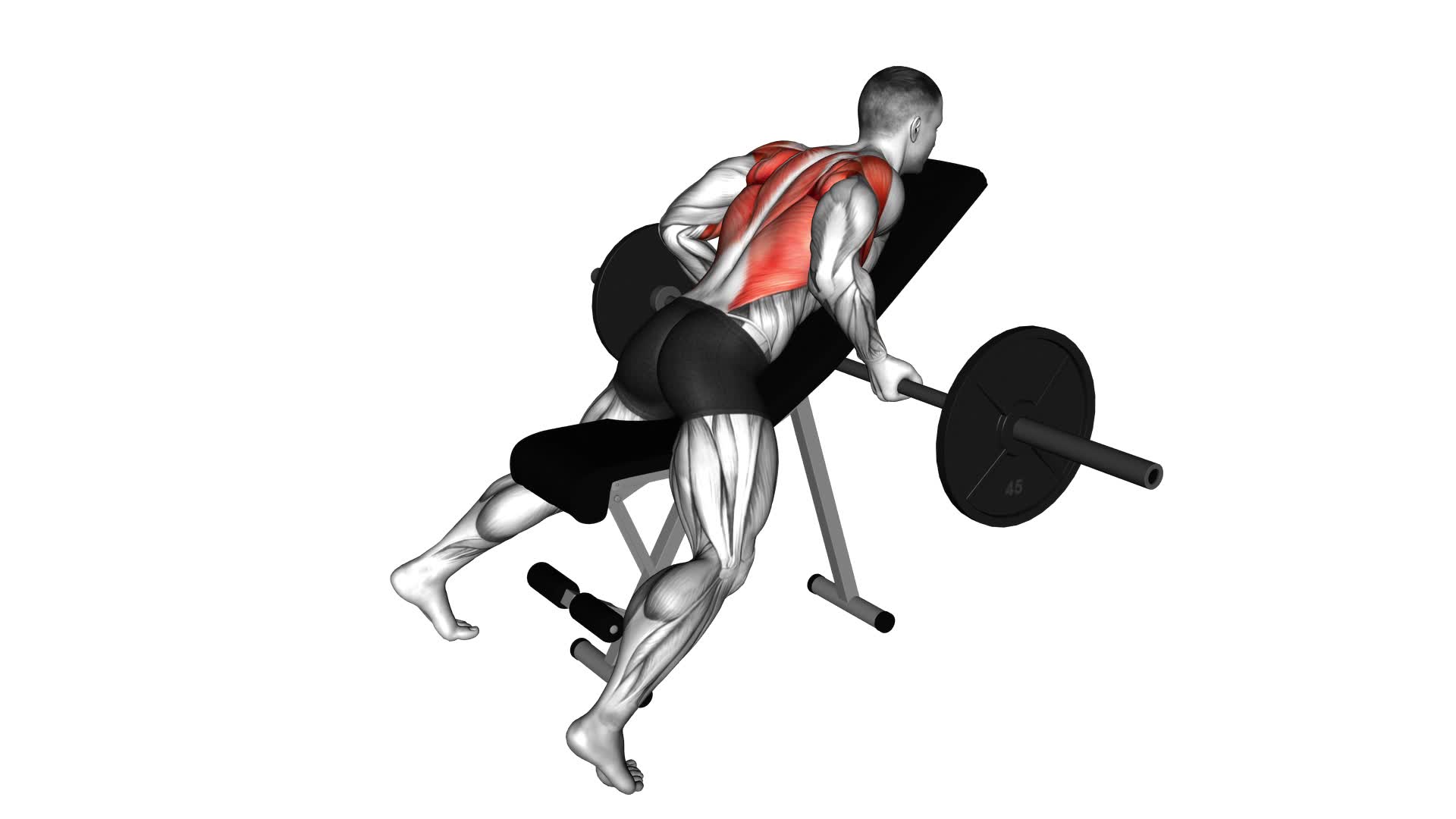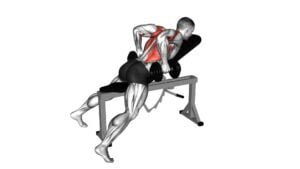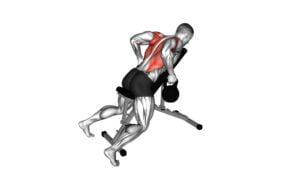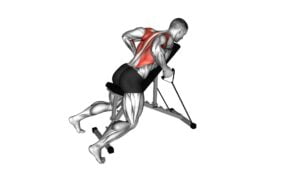Barbell Reverse Grip Incline Bench Row – Video Exercise Guide & Tips

Are you looking to target your upper back and build strength? The Barbell Reverse Grip Incline Bench Row is a great exercise for you.
Watch This Exercise Video
With this movement, you'll engage your muscles while maintaining proper form and technique.
Not only will you benefit from increased strength, but you'll also improve your posture and stability.
In this article, we'll provide you with a video exercise guide and valuable tips to help you perfect your Barbell Reverse Grip Incline Bench Row.
Let's get started!
Key Takeaways
- Targets different muscles compared to traditional grip
- Engages biceps for arm strength and size
- Targets upper back muscles for improved posture and definition
- Activates core muscles for enhanced core strength
Benefits of the Barbell Reverse Grip Incline Bench Row
The barbell reverse grip incline bench row offers significant benefits for your upper body strength and muscle development. Incorporating variations of this exercise into your routine can provide you with a range of advantages.
Firstly, the reverse grip targets different muscles compared to the traditional grip. By using an underhand grip, you engage your biceps more, which helps in developing arm strength and size.
Additionally, this exercise also targets your upper back muscles, including the rhomboids, rear delts, and traps, leading to improved posture and a more defined back.
Another benefit of the barbell reverse grip incline bench row is the activation of your core muscles. This exercise requires stability and balance, which engages your abs and obliques, ultimately enhancing your overall core strength.
Equipment Needed for the Exercise
To perform the Barbell Reverse Grip Incline Bench Row, you'll need some essential equipment.
Firstly, you'll need a barbell with weight plates that you can adjust according to your strength and fitness level.
Additionally, an incline bench is necessary to provide support and stability during the exercise.
If you don't have access to a barbell or an incline bench, you can use alternative equipment such as dumbbells and an adjustable bench.
However, it's important to prioritize safety and ensure that the equipment you use is stable and suitable for the exercise.
Essential Equipment for Exercise
To effectively perform the Barbell Reverse Grip Incline Bench Row exercise, all you need is proper equipment. Here is a list of essential equipment needed for this exercise:
- Barbell: This is the main equipment used for the exercise. It provides resistance and targets the muscles in your back and arms.
- Incline Bench: The incline bench allows you to perform the exercise at an angle, targeting specific muscles in your back and providing stability.
- Weight Plates: These are added to the barbell to increase the resistance and intensity of the exercise.
- Grips: Reverse grip handles or straps can be used to ensure a secure and comfortable grip on the barbell.
With these essential pieces of equipment, you can effectively perform the Barbell Reverse Grip Incline Bench Row exercise and target your back and arm muscles.
However, if you don't have access to these specific items, there are alternative exercises that can still help you achieve similar results.
Alternatives to Required Equipment
If you don't have access to the necessary equipment, there are alternative exercises that can still provide similar results for targeting your back and arm muscles.
Bodyweight exercises can be a great option when equipment is unavailable. Push-ups, for example, engage your chest, shoulders, and triceps while also activating your back muscles. You can vary the intensity by adjusting your hand placement or adding a clap for explosive power.
Another alternative is resistance band exercises. Resistance bands are versatile and portable, allowing you to perform rows, pull-aparts, and lateral raises to target your back and arm muscles.
Safety Considerations for Equipment
For optimal safety while performing the Barbell Reverse Grip Incline Bench Row, ensure that you have the necessary equipment. Here are some safety considerations and alternatives for the required equipment:
- Barbell: Use a barbell that's appropriate for your strength level. Make sure it's securely fastened with collars to prevent any sliding or shifting during the exercise.
- Incline Bench: Ensure that the incline bench is stable and securely positioned. Adjust the bench to an appropriate incline angle that allows for proper form and range of motion.
- Reverse Grip: Use a grip that's comfortable for you and allows for a secure hold on the barbell. Avoid excessive wrist flexion or extension.
- Safety Spotter: If possible, have a spotter nearby to assist you in case you need help or lose control of the barbell.
Proper Form and Technique for the Barbell Reverse Grip Incline Bench Row
To perform the barbell reverse grip incline bench row with proper form and technique, it's important to focus on your grip and positioning.
Make sure to use a reverse grip, with your palms facing towards you, and position yourself on an incline bench with your chest supported.
Additionally, engage your back and shoulders throughout the movement to ensure proper muscle activation and prevent any strain or injury.
Grip and Positioning
Hold the barbell with a reverse grip and position yourself on the incline bench for the Barbell Reverse Grip Incline Bench Row. To ensure proper grip technique, make sure your hands are shoulder-width apart, palms facing up, and thumbs wrapped around the barbell. Maintain a firm grip throughout the exercise to prevent the barbell from slipping.
For optimal body positioning, lie on the incline bench with your chest pressed against the pad and your feet flat on the floor. Keep your back straight and engage your core muscles for stability. Maintain a slight bend in your knees and avoid arching your back. This position will help you maintain control and stability while performing the exercise.
Back and Shoulder Engagement
Maintain proper back and shoulder engagement during the Barbell Reverse Grip Incline Bench Row to maximize the effectiveness of the exercise.
Back and shoulder engagement refers to the activation of specific muscles in these areas to ensure proper form and technique.
When performing this exercise, focus on keeping your back straight and your shoulders pulled back and down. This will help to activate the muscles in your upper back, such as the rhomboids and trapezius, as well as the muscles in your shoulders, such as the deltoids.
Modifications and Variations to Challenge Yourself
Challenge yourself by incorporating modifications and variations into your Barbell Reverse Grip Incline Bench Row workout. These modifications and progressions will help you continuously challenge your muscles and prevent plateaus. Here are some variations to try:
- Increase the weight: Gradually add more weight to the barbell as you get stronger. This will increase the intensity of the exercise and further engage your back and shoulders.
- Use resistance bands: Attach resistance bands to the barbell to add extra resistance and challenge your muscles even more.
- Single-arm rows: Instead of using both arms simultaneously, try performing the exercise with one arm at a time. This will increase the stability required and target each side of your back individually.
- Pause at the top: When you reach the top of the row, hold the position for a few seconds before lowering the barbell back down. This will increase the time your muscles are under tension and enhance muscle growth.
By incorporating these modifications and variations, you can maximize the effectiveness of your Barbell Reverse Grip Incline Bench Row workout and continue making progress.
Now, let's move on to the next section and discuss common mistakes to avoid while performing this exercise.
Common Mistakes to Avoid While Performing the Exercise
To prevent common mistakes and optimize your performance, be mindful of the following points while performing the Barbell Reverse Grip Incline Bench Row exercise.
- One common mistake to avoid is using improper form and technique. It's important to maintain a neutral spine throughout the exercise and avoid rounding your back. This can put unnecessary strain on your lower back and increase the risk of injury.
- Additionally, make sure to keep your elbows close to your body and avoid flaring them out to the sides. This will help target the muscles in your back more effectively.
- Another mistake to watch out for is using too much weight. It's important to start with a weight that allows you to maintain proper form and complete the exercise with control. Using too much weight can compromise your form and increase the risk of injury.
By paying attention to these common mistakes and focusing on proper form and technique, you can ensure a safe and effective workout.
Now, let's move on to the next section to learn some tips for incorporating the barbell reverse grip incline bench row into your workout routine.
Tips for Incorporating the Barbell Reverse Grip Incline Bench Row Into Your Workout Routine
Are you wondering how to effectively incorporate the Barbell Reverse Grip Incline Bench Row into your workout routine? This exercise is a great way to target your upper back muscles while also engaging your biceps and shoulders. Here are some tips to help you incorporate this exercise into your routine:
- Start with a warm-up: Before performing the Barbell Reverse Grip Incline Bench Row, it's important to warm up your muscles. You can do this by doing some light cardio exercises or dynamic stretches.
- Incorporate other row exercises: To add variety to your workout routine and target different muscle groups, consider incorporating other row exercises such as the bent-over row or the seated cable row. This will help you work your back muscles from different angles.
- Vary the weight and reps: To challenge your muscles and promote growth, it's important to vary the weight and number of reps you perform. You can start with a lighter weight and higher reps for endurance, and gradually increase the weight and decrease the reps as you get stronger.
- Understand the benefits of incline bench exercises: Incline bench exercises, such as the Barbell Reverse Grip Incline Bench Row, help target the upper portion of your back and shoulders. By incorporating these exercises into your routine, you can improve your posture, increase upper body strength, and enhance overall muscle definition.
Frequently Asked Questions
How Many Sets and Reps Should I Do for the Barbell Reverse Grip Incline Bench Row?
To improve back strength, you should focus on doing multiple sets and reps of the barbell reverse grip incline bench row. This exercise targets your upper back muscles and can be a great variation of the standard barbell row.
Start with a weight that challenges you but allows you to maintain proper form. Aim for 3-4 sets of 8-12 reps, gradually increasing weight as you get stronger.
Remember to always consult with a fitness professional before starting any new exercise routine.
Can the Barbell Reverse Grip Incline Bench Row Help Improve My Posture?
The barbell reverse grip incline bench row is a great exercise to improve your posture. By engaging your back muscles and pulling the weight towards your chest, this exercise helps strengthen your upper back and shoulders, which can help correct rounded shoulders and forward head posture.
It's important to maintain proper form and technique throughout the exercise to prevent injury. Focus on keeping your back straight, retracting your shoulder blades, and using a controlled movement.
Is the Barbell Reverse Grip Incline Bench Row Suitable for Beginners?
Proper form is important for the barbell reverse grip incline bench row. It's a beneficial exercise for beginners as it helps improve posture and strengthens the upper back and shoulders.
By using the reverse grip, you engage different muscles compared to a traditional row. This exercise targets the rhomboids, trapezius, and rear deltoids, promoting better posture and reducing the risk of shoulder injuries.
Incorporate the barbell reverse grip incline bench row into your routine to see improvement in your upper body strength and posture.
Can I Substitute the Barbell With Dumbbells for This Exercise?
Yes, you can substitute the barbell with dumbbells for the reverse grip incline bench row. This exercise allows for variations and modifications to fit your needs.
Using dumbbells instead of a barbell can offer a different range of motion and engage different muscles in your back and arms.
Be sure to maintain proper form and start with a weight that challenges you but allows you to perform the exercise correctly.
How Often Should I Include the Barbell Reverse Grip Incline Bench Row in My Workout Routine?
Including the barbell reverse grip incline bench row in your workout routine has numerous benefits. It targets your upper back, biceps, and shoulders, helping to build strength and muscle definition.
To properly execute this exercise, start by setting the incline bench to a comfortable angle. Then, grab the barbell with an underhand grip and pull it towards your chest, squeezing your shoulder blades together.
Aim to incorporate this exercise into your routine 2-3 times per week for optimal results.
Conclusion
Incorporating the barbell reverse grip incline bench row into your workout routine can offer several benefits.
This exercise targets your upper back, shoulders, and arms while also engaging your core muscles.
By using proper form and technique, you can maximize the effectiveness of this exercise and avoid common mistakes.
Don't forget to challenge yourself with modifications and variations as you progress.
With the right equipment and dedication, the barbell reverse grip incline bench row can be a valuable addition to your fitness routine.

Author
Years ago, the spark of my life’s passion ignited in my mind the moment I stepped into the local gym for the first time. The inaugural bead of perspiration, the initial endeavor, the very first surge of endorphins, and a sense of pride that washed over me post-workout marked the beginning of my deep-seated interest in strength sports, fitness, and sports nutrition. This very curiosity blossomed rapidly into a profound fascination, propelling me to earn a Master’s degree in Physical Education from the Academy of Physical Education in Krakow, followed by a Sports Manager diploma from the Jagiellonian University. My journey of growth led me to gain more specialized qualifications, such as being a certified personal trainer with a focus on sports dietetics, a lifeguard, and an instructor for wellness and corrective gymnastics. Theoretical knowledge paired seamlessly with practical experience, reinforcing my belief that the transformation of individuals under my guidance was also a reflection of my personal growth. This belief holds true even today. Each day, I strive to push the boundaries and explore new realms. These realms gently elevate me to greater heights. The unique combination of passion for my field and the continuous quest for growth fuels my drive to break new ground.







